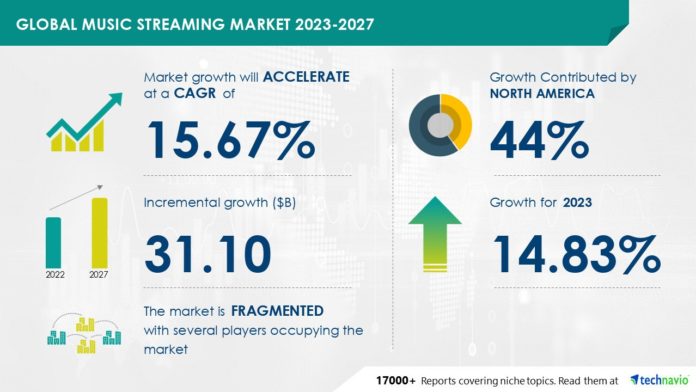The global music streaming market size is estimated to grow by USD 31.10 bn from 2023-2027, according to Technavio. The market is estimated to grow at a CAGR of over 15.67% during the forecast period.
The global music streaming market is witnessing a surge in differentiated services from vendors such as YouTube Music, Pandora, Spotify, Deezer, and Tidal. These platforms offer features like easy accessibility, auto playlist customization, high audio quality, personalized recommendations, and various interactive and social functionalities. Additionally, they are expanding globally, localizing content, and integrating with smart devices, virtual assistants, and 5G technology for enhanced user experience. Key technologies include AI-driven personalization, lossless streaming, and virtual concerts, while subscription bundling and user-generated content cater to diverse user needs.
The digital music publishing landscape is dominated by subscription-based music streaming services, driven by high-quality streams and advancements in technologies like 5G and 4G. Consumers access vast music collections, yet cannot own the content, requiring constant internet connection. This lack of ownership may hinder market growth, as individuals and businesses in sectors like restaurants and gyms utilize music streaming services, OTT platforms, and websites for audio and video content via application- or web-based platforms. Unauthorized streaming and live videos on social media add complexity, while AI and ML enhance user experience with features like rewind, fast-forward, and pause. Revenue channels include subscription fees, advertising, and prime membership benefits.
The music streaming market is experiencing significant growth in various sectors, including restaurants, cafeterias, salons, and gyms, where consumers seek an immersive audio-visual experience. Cloud-based infrastructure supports application- and web-based platforms, enabling live streaming, rewind, fastforward, and pause features for both audio and video content. Revenue channels include non-subscription models, such as ad-based services, and subscription plans catering to individual and commercial use. Interactive and social features, like collaborative playlists, user-generated content, and remix culture, foster engagement and global expansion. High-fidelity and lossless streaming, AI-driven personalization, live audio, and virtual concerts cater to diverse consumer preferences. Smart devices, smart speakers, alarms, voice command, and virtual assistants facilitate seamless integration into daily life. Network connection, data transfer rates, and latency impact user experience, while smart home devices and buffering times require optimization for optimal performance.
In the contemporary digital landscape, the Music Streaming Market has experienced significant growth, driven by advancements in technology and consumer demand. Smart devices, equipped with 5G connectivity, enable high-quality Music Streams, allowing consumers to access Music videos, Podcasts, Audio files, and Music streams seamlessly. 5G technology’s faster connectivity surpasses 4G, enhancing the user experience. Music Streaming Services, including OTT platforms, offer Prime membership benefits, such as AI and ML features, enabling personalized recommendations. However, unauthorized music streaming remains a challenge for the Music Industry. Social media websites like YouTube Live and Facebook Periscope host live Music videos, further expanding the market’s reach. Individual segments, such as Restaurants, Cafeterias, Salons, and Gyms, leverage cloud-based infrastructure for live streaming Music, catering to diverse consumer preferences. The Music Streaming Market continues to evolve, offering consumers a rewind feature and more, ensuring an immersive and engaging experience.
The Music Streaming Market is a significant segment of the digital entertainment industry, driven by advanced technologies and consumer preferences. Platforms such as Musics, Smart Technology, and On-Demand Services enable users to access a vast library of tunes from various artists and genres. Podcasts and video content are also integrated into these services, expanding their offerings. The market is competitive, with players like Audio Devices and Social Media offering streaming services. Consumers value convenience, affordability, and personalized recommendations, leading to increased demand for these services. The use of Artificial Intelligence and Machine Learning technologies further enhances the user experience by providing customized playlists and recommendations. The market is expected to grow further with the integration of Virtual and Augmented Reality technologies, offering immersive music experiences.







